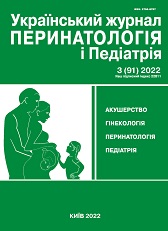Modern concept and organization of medical nutrition for children in health care institutions of Ukraine
DOI:
https://doi.org/10.15574/PP.2022.91.68Keywords:
medical nutrition, modern conception components, methodology of prescription, dietitian, dietitian nurseAbstract
The system of diets according to groups of diseases (Pevzner’s diets), developed back in the 1920s, was the basis of medical nutrition in the USSR and for about 20 years in Ukraine. The lack of diseases effective treatment schemes and measures caused such a long period of its use.
The aim of present investigation is to highlight the main principles of modern concept of medical nutrition in pediatrics and to describe main aspects of methodology of its apporintment.
In recent decades, ideas about the pathogenesis of various pathologies have changed, new effective methods of therapy have been introduced, and modern challenges (such as overweight or food allergies) have intensified. On the one hand, this required individualization, and on the other, it made it possible to liberalize the diet of patients. According to the new concept of dietary nutrition, all patients need a diet that is adequate in terms of energy value and balanced in terms of the composition of the most important nutrients, taking into account the stage of the disease and individual characteristics of the child’s organism (intolerance of certain products, food preferences etc.). A peculiarity of the methodology of prescribing medical nutrition for children is taking into account the physiological needs of the child for his age. The persons responsible for the organization of medical nutrition in health care institutions are a nutritionist and a dietitian nurse.
No conflict of interests was declared by the authors.
Keywords: medical nutrition, modern conception components, methodology of prescription, dietitian, dietitian nurse.
References
, Henning M. (2009, Sep-Oct). Nursing's role in nutrition. Comput Inform Nurs. 27 (5): 301-306. URL: https://pubmed.ncbi.nlm.nih.gov/19726924/. https://doi.org/10.1097/NCN.0b013e31819f7ca8; PMid:19726924
, Isanaka S, Villamor E, Shepherd S et al. (2009). Assessing the impact of the introduction of the World Health Organization growth standards and weight-for-height z-score criterion on the response to treatment of severe acute malnutrition in children: secondary data analysis. Pediatrics. 123: e54-10. https://doi.org/10.1542/peds.2008-1375; PMid:19117847 PMCid:PMC3161727
Kuzminska OV. (2017). Suchasni pidkhody do osnovnykh zasad zdorovoho ta likuvalnoho kharchuvannia. Medychna hazeta «Zdorov'ia Ukrainy 21 storichchia». 21 (418): 20-21.
MOZ Ukrainy. (2013). Pro udoskonalennia orhanizatsii likuvalnoho kharchuvannia ta roboty diietolohichnoi systemy v Ukraini. Nakaz MOZ Ukrainy vid 29.10.2013 No. 931
MOZ Ukrainy. (2013). Pro zatverdzhennia metodychnykh rekomendatsii dlia likariv zahalnoi praktyky - simeinoi medytsyny z pryvodu konsultuvannia patsiientiv shchodo osnovnykh zasad zdorovoho kharchuvannia. Nakaz MOZ Ukrainy vid 14.01.2013 No. 15.
MOZ Ukrainy. (2017). Pro zatverdzhennia norm fiziolohichnykh potreb naselennia Ukrainy v osnovnykh kharchovykh rechovynakh i enerhii. Nakaz MOZ Ukrainy vid 03.09.2017 No. 1073.
Serón-Arbeloa C, Labarta-Monzón L, Puzo-Foncillas J. (2022). Malnutrition screening and assessment. Nutrients. 14: 12. https://doi.org/10.3390/nu14122392; PMid:35745121 PMCid:PMC9228435
Styne DM, Arslanian SA, Connor EL, Farooqi IS, Murad MH, Silverstein JH et al. (2017, Mar 1). Pediatric Obesity-Assessment, Treatment, and Prevention: An Endocrine Society Clinical Practice Guideline. J Clin Endocrinol Metab. 102 (3): 709-757. https://doi.org/10.1210/jc.2016-2573; PMid:28359099 PMCid:PMC6283429
WHO. (2021). Materialy VOOZ «Zdorov'ia-21: osnovy polityky dosiahnennia zdorov'ia dlia vsikh u Yevropeiskomu rehioni VOOZ». URL: https://apps.who.int/iris/bitstream/handle/10665/345924/WHO-EURO-2021-1919-41670-59496-ukr.pdf?sequence=1&isAllowed=y.
Yoo H, Suneja U. (2021). Pediatric obesity nutritional guidelines. URL: https://www.ncbi.nlm.nih.gov/books/NBK560926/.
Downloads
Published
Issue
Section
License
Copyright (c) 2022 Ukrainian Journal of Perinatology and Pediatrics

This work is licensed under a Creative Commons Attribution-NonCommercial 4.0 International License.
The policy of the Journal “Ukrainian Journal of Perinatology and Pediatrics” is compatible with the vast majority of funders' of open access and self-archiving policies. The journal provides immediate open access route being convinced that everyone – not only scientists - can benefit from research results, and publishes articles exclusively under open access distribution, with a Creative Commons Attribution-Noncommercial 4.0 international license(СС BY-NC).
Authors transfer the copyright to the Journal “MODERN PEDIATRICS. UKRAINE” when the manuscript is accepted for publication. Authors declare that this manuscript has not been published nor is under simultaneous consideration for publication elsewhere. After publication, the articles become freely available on-line to the public.
Readers have the right to use, distribute, and reproduce articles in any medium, provided the articles and the journal are properly cited.
The use of published materials for commercial purposes is strongly prohibited.

